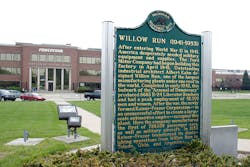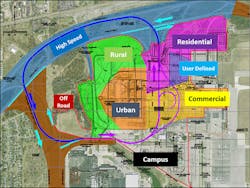Self-driving cars will begin taking test laps this December on the site of a famous World War II airplane factory in Michigan where Rosie the Riveter helped produce a shiny B-24 Liberator bomber every hour more than seven decades ago.
Driverless cars — some without steering wheels, accelerators or brake pedals — will race at speeds of up to 70 miles per hour around a 2.5-mile loop that includes a triple-decker overpass, a 700-foot tunnel and a decommissioned federal highway. The test track, known as the American Center for Mobility, is under construction on the grounds of the former Willow Run factory that was a critical cog in Detroit's famed Arsenal of Democracy during World War II.
The facility in Ypsilanti, Michigan, is one of 10 test beds around the country the U.S. has designated as official sites for validating driverless technology. Automakers, suppliers and technology companies will share the $110 million facility to accelerate the arrival of autonomous cars. Eventually, the 500-acre center will feature fake suburban neighborhoods, rural country roads and urban streets with robot pedestrians darting into traffic. The test track will include a full-size freeway interchange with looping on and off ramps.
"Here's the reality: These vehicles are going to happen and it is going to transform mobility in the world," Debbie Dingell, a Democratic congresswoman from Michigan, said during a tour of the facility Tuesday. "And it's either going to happen in America or it's going to happen in China or India or western Europe. And we are not going to let that happen."
Earth movers and front loaders are now building bridges and overpasses on the vast site where the factory was leveled a few years ago. The test track spills out onto the adjoining U.S. 12 highway, where autonomous test cars will take over two eastbound lanes as regular traffic is rerouted to the westbound lanes on a 1.5-mile section of the lightly traveled roadway.
Dingell was accompanied by Bob Latta, the Ohio Republican who chairs the House Energy and Commerce Committee's Digital Commerce and Consumer Protection panel. In a rare show of bipartisanship, Latta's panel last month unanimously approved legislation that allows manufacturers to test thousands of self-driving vehicles on public roads while safety regulators come up with rules for driverless rides. The bill would also prohibit states from regulating the mechanical, software and safety systems of autonomous cars.
"We're looking five and 10 years out," Latta said. "We don't want to have legislation out there or regulations that are going to stymie development" of autonomous vehicles.
Latta said developing self-driving cars is imperative because U.S. roadway deaths jumped 14 percent over the last two years, with more than 40,000 people dying in crashes in 2016. Federal statistics show that 94 percent of highway fatalities are the result of human error.
"I'd like to think right now that the United States is on the forefront" of developing self-driving cars, Latta said. "We want to stay at the front, so we don't want to put roadblocks up."
Detroit and Silicon Valley, vying for supremacy over autonomous autos, each have official test sites in their backyards. GoMentum Station, a decommissioned Naval base in Concord, California, also was named an official test site. There, 20 miles of roads weave around empty barracks, a mess hall, gymnasium and bowling alley.
"I'm tired of this California versus the Midwest" competition, Dingell said. "We need to give a whole hell of a lot more credit to what is happening here and what is being built in Michigan, Ohio and the Midwest. We are at the forefront of that innovation."













